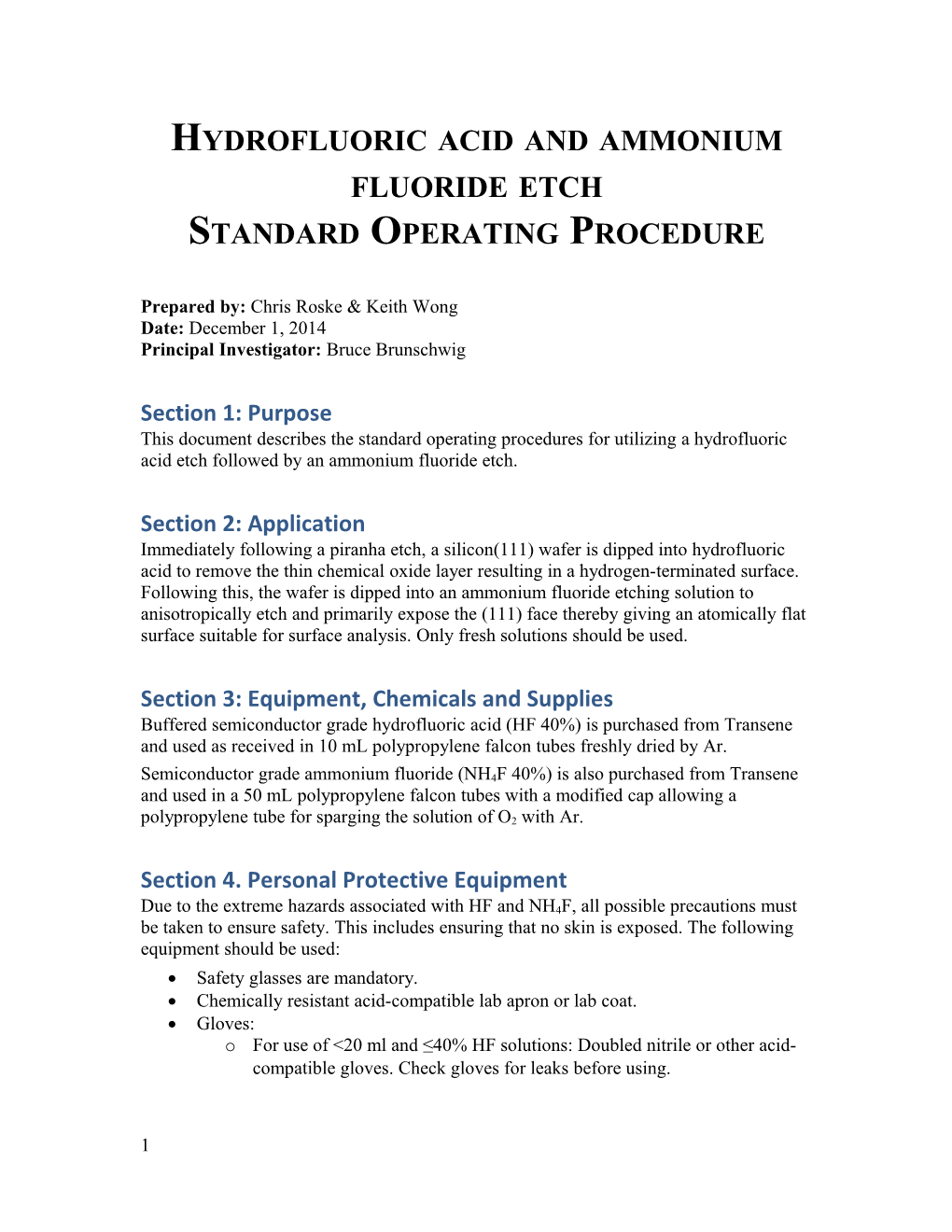Hydrofluoric acid and ammonium fluoride etch
Standard Operating Procedure
Prepared by: Chris Roske & Keith Wong
Date: December 1, 2014
Principal Investigator: Bruce Brunschwig
Section 1: Purpose
This document describes the standard operating procedures for utilizing a hydrofluoric acid etch followed by an ammonium fluoride etch.
Section 2: Application
Immediately following a piranha etch, a silicon(111) wafer is dipped into hydrofluoric acid to remove the thin chemical oxide layer resulting in a hydrogen-terminated surface. Following this, the wafer is dipped into an ammonium fluoride etching solution to anisotropically etch and primarily expose the (111) face thereby giving an atomically flat surface suitable for surface analysis. Only fresh solutions should be used.
Section 3: Equipment, Chemicals and Supplies
Buffered semiconductor grade hydrofluoric acid (HF 40%) is purchased from Transene and used as received in 10 mLpolypropylene falcon tubes freshly dried by Ar.
Semiconductor grade ammonium fluoride (NH4F 40%) is also purchased from Transene and used in a 50 mL polypropylene falcon tubes with a modified cap allowing a polypropylene tube for sparging the solution of O2 with Ar.
Section 4. Personal Protective Equipment
Due to the extreme hazards associated with HFand NH4F, all possible precautions must be taken to ensure safety. This includes ensuring that no skin is exposed. The following equipment should be used:
- Safety glasses are mandatory.
- Chemically resistant acid-compatible lab apron or lab coat.
- Gloves:
- For use of <20 ml and ≤40% HF solutions: Doubled nitrile or other acid-compatible gloves. Check gloves for leaks before using.
- For use of >20 ml and/or >40% HF solutions: thick neoprene gloves, acid resistant lab apron.
- Closed-toe shoes (no sandals) and pants (no shorts).
Section 5: Operational Procedures
Note: HF is extremely corrosive. Both liquid and vapor can cause severe burns. HF can cause burns not felt for hours prior to liquefactive necrosis becomingapparent. The danger of HF is in its weak acidic strength, which allows it to penetrate skin and other tissuesall while slowly dissociating into hydrogen and fluoride ions, each ion is destructive in different ways. Fluoride ions readily bind calcium resulting in decalcification of bones and cardiac arrhythmia. Hydrogen ions destroy tissue consistent with other traditional acids.Exposure of ~25 in2of body surface can result in fatality by cardiac arrest.
NH4F should be handled with the same caution.
- To use HF or NH4F etches you must have had specific laboratory safety training and be authorized by the lab safety officer prior to doing any work.
- Adorn proper safety attire (described in section 6) and prepare working area in the hood.
- Locate the safety shower, and eye wash.
- Prepare proper container for HF etch and place in secondary containment. Remember, HF MUST be used in plastic containers, and never glass because it readily etches SiOx. Teflon is OK. Prepare a proper container for HF waste, aplastic funnel situated on a plastic waste container for spent etchant.
- Pour 10 mL of NH4F into a 50 mL polypropylene falcon tube and purge with Ar for 45 minutes prior to use.
- Pour 5 mL of buffered HF into the 10 mL polypropylene falcon tube. Close the lid and return the reagent bottle to storage.
- Removal of thin oxide layers from a wafer requires at most 20 seconds; place the wafer into the falcon tube using HF-compatible tweezers (no metal).
- Empty the falcon tube into the plastic funnel after the desired etch time, being careful to let all excess HF drip off into the funnel.
- Rinse the sample collected in the funnel with 18 MΩ water. The water from at least the first three rinse cycles should be treated as HF waste and disposed of accordingly.
- The sample can then be transferred into the ammonium fluoride and sealed while continuing to sparge with Ar. After 5 minutes the sample can be collected on the same plastic funnel and washed before further processing.
- Examine the workspace carefully to ensure that there are no wet spots. Clean up any wet spots as if they were HF. Also inspect gloves and lab coat.
Section 6. Primary Hazards
HF is extremely corrosive and can quickly cause extreme burns to skin and severe damage to eyes. As described above, it readily penetrates skin, and can cause slow-to-heal burns.
Buffered Hydrofluoric acid:
HF is a contact-poison, it is rated a 4 (out of 4) on the health scale. HF vapor is also extremely dangerous which is why it should only be used within a properly vented fumehood.
Ammonium Fluoride:
Rated 3/4 (out of 4) on the health scale. NH4F is very hazardous in the case of skin contact, eye contact, or inhalation.
Section 7. Engineering Controls to Prevent and Mitigate Hazards
All operations with HF and NH4Fmust be performed in a fume hood, which is close to an eye wash station and shower. All containers forHF or NH4F must have secondary containment at all times.
Section 8. First Aid and Emergency Procedures
Eye contact:
Immediately flush eyes with plenty of running water for at least 15 minutes. Speed is extremely important. Obtain medical attention as soon as possible. Do not apply calcium gluconate gel to eyes.
Skin contact:
Immediately flush affected areas with water for at least 15 minutes, removing contaminated clothing while under the safety shower. After washing apply 2.5 % calcium gluconate gel to affected area and re-apply every 15 minutes until medical assistance arrives.
In case of a spill:
All spills outside of fume hood require immediate evacuation, EH&S should be notified.
Spills inside fumehood can be dealt with powdered calcium gluconate available in the hood
1
